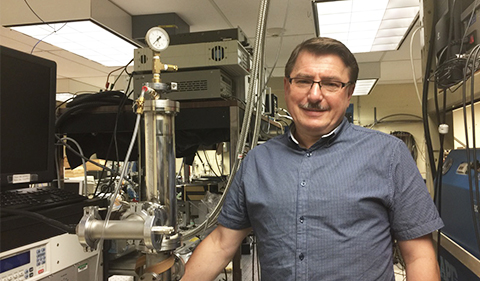
Dr. Wojciech Jadwisienczak at his lab in Stocker Center
By Ling Xin
NQPI Editorial Intern
Nanoscale and Quantum Phenomena Institute 2019 Fall Newsletter
As a materials research scientist and electrical engineer, Dr. Wojciech Jadwisienczak specializes in optical spectroscopy, a technique that uses light to understand the structure and properties of materials. A member of the Ohio University Nanoscale and Quantum Phenomena Institute (NQPI) and working at the University’s Russ College of Engineering and Technology for more than two decades, he has been especially interested in two categories of materials: lanthanides and III-nitride semiconductors. Mixed together at the atomic level, the two can help develop more efficient light-emitting diodes (LEDs), a type of semiconductor light source widely used these days for its low energy consumption, long lifespan and small size.
Lanthanides, also known as rare earths, are a family of metal elements appearing at the bottom of the periodic table. “With abundant electrons and a special 4f-shell electron structure, these elements show intriguing optical and magnetic properties for versatile technological applications,” said Jadwisienczak, “from white light LEDs found in many indoor and outdoor lighting applications, to the cellphone flashlight in everybody’s pocket, to fridge magnets, motors in electric cars and the materials used for making stealth aircraft.”
Adding a small amount of a selected lanthanide to a III-nitride LED material such as gallium nitride (GaN) or indium gallium nitride (InGaN) — a process known as “doping” — has shown to improve the materials’ quality and performances in the resulting LEDs. Previously, Jadwisienczak collaborated with scientists from Osaka University who successfully doped europium atoms in the GaN crystal with the highly controlled and atomically precise epitaxial growth method. Next, using various spectroscopy techniques, they observed excellent luminescence in the red spectral region, a challenging color to obtain for III-nitride LEDs.
“Eu3+ is well-known for its red emissions regardless of host materials. While green and blue III-nitride LEDs had been achieved, red is still a missing fundamental color,” he said.
The role of lanthanides extends beyond their optical and magnetic properties. A more recent study by Jadwisienczak and his collaborators from OHIO and the University of Puerto Rico found that doping InGaN with ytterbium could improve the structure and intrinsic optical properties of the material as a whole.
Optical spectroscopy results showed that Yb3+ acts as a morphological modifier and helps indium atoms migrate to the right position during the process of material growth. “It’s like when you bake a cake,” Jadwisienczak explained. “You want all the raisins to end up distributing evenly all over the cake rather than clustering in one spot. And we believe ytterbium helps to achieve a more homogenous indium distribution.”
This finding may help to improve the quality of high-indium-content InGaN in the future. “It is important because by adding ytterbium and varying the concentration of indium, we can extend the material’s emission spectrum from blue to green to red, which means possibly producing all three fundamental colors in one material. This approach is different from europium doping to III-nitrides,” he added.
For future research, Jadwisienczak plans to collaborate with Dr. Eric Stinaff, a materials scientist from Physics & Astronomy, to grow single-layer molybdenum disulfide (MoS2) and other 2D materials doped with lanthanides to explore their optical and magnetic properties.
As one of the first members of NQPI since its inauguration in 2000, Jadwisienczak said his research has benefited greatly from the Institute. Materials science requires expertise from different areas, and being part of an institute like NQPI “opens up venues for collaborations.” It offers access to existing research facilities on campus and helps increase the visibility of researchers’ work, among many other things. Jadwisienczak’s previous collaboration with NQPI members including, among others, Dr. Arthur Smith and Dr. Martin Kordesch, were very fruitful. “NQPI has been useful and successful in the past, and I look forward for this vibrant organization to grow in the future.”



















Comments